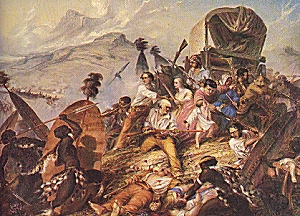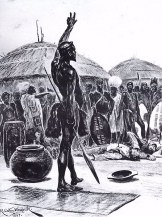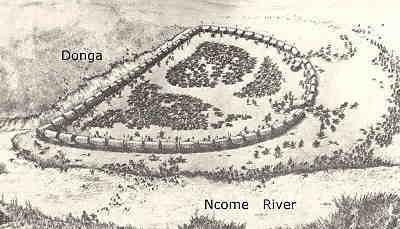Battle of Blood River. Afrikaner (Boer) victory
Battle of Blood River. An estimated 10 000 Zulus defeated by 470 Afrikaners
In Natal (today's KwaZulu-Natal), at the close of the 18th century, Dingiswayo, founder of the Zulu state introduced a ruthless
military system. It was further developed by his successor, Chaka (Shaka), during whose reign the Zulu power and state was
firmly established in 1816, and the Zulu name became a terror to all the surrounding peoples. They became most feared
warriors in Africa. "Zulus" are so named from a legendary chief Zulu, ancestor of Dingiswayo.
Dingane (Dingaan) kaSenzangakhona Zulu became king of the Zulu dynasty in 1828 after assassinating his half-brother
Shaka with the help of another brother, Umhlangana, as well as Shaka's advisor Mbopa.
Then came the Voortrekker (Boer, Afrikaner) - Zulu chapter of treachery, murder, victory and death of the Zulu king Dingane.
Voortrekker, name given to Afrikaners (or Boers) who migrated north from the British Cape Colony (modern southwestern South Africa)
during what became known as the Great Trek (1835-1843). The word Voortrekker means "pioneer" in the
Afrikaans language. The migration of the Voortrekkers marked the birth of Afrikaner nationalism and the determination of
Afrikaner, settlers of Dutch and French Huguenot descent, to shake off British control. In the course of the Great Trek,
the Voortrekkers fought the British, Zulu and other Bantu-speaking peoples for their land. The Voortrekkers then established the Afrikaner republics
of the Orange Free State and the South African Republic (in the Transvaal region).
Leaders of the Voortrekkers, such as Hendrik Potgieter, Andries Pretorius, Pieter Retief, and Dirk Uys, are among the
most revered names in Afrikaner history. The Voortrekker Monument in Pretoria, inaugurated in 1949, was built as a
symbol of Afrikaner nationalism, and as a celebration of the Great Trek.
The murder of Piet Retief
It all started in November 1837 when Piet Retief and his delegation of about 100 men met face to face with Dingaan in his
Zulu capital (kraal) Umgungundlovu to peacefully negotiate land for the Voortekkers from the Zulus. The land lays beyond
the southern border (Tugela and its principal tributary the Buffalo) of the then Zulu kingdom. Dingaan agreed to make a land
grant on the condition that Retief return his cattle that had been stolen by Chief Sekonyela.
In a short space of time Retief recovered the cattle which Chief Sekonyela of the Tlokwa had stolen and returned them to
Dingaan. By then the Voortrekkers with their wagons and cattle were already streaming into the territory south of the Zulu
kingdom. Dingaan who was deeply suspicious of Piet Retief and his followers was fully aware of the Boers military power.
He learned that they had defeated the Ndebele or amaNdebele also known as the Matabele (originally a branch of the Zulu
people) and their leader Mzilikazi (Mosilikatze) in 1836/1837. This is what happened:
On 16 October, 1836, at Vegkop, near the present-day town of Heilbron, 5000 Matabele warriors led by Mzilikazi attacked
Potgieter's laager. Thirty-three Afrikaner men and seven boys had defeated the 5000 Matabele's. The latter withdrew and
made off with all the trekker stock. Only two Trekkers had been killed, one of them Nicholas Potgieter, brother of Hendrik
Potgieter.
Punitive raids
On 16 January 1837 Potgieter and Maritz with a small force attacked Matabele kraals at Mosega killing scores of Matabele's.
A second and final attack by Potgieter and Piet Uys on Mzilikazi and the Matabele's followed in October/
November 1837. An estimated 3000 Matabele's lost their lives while the remainder and their leader Mzilikazi fled north
across the Limpopo.
A treaty between Dingaan and Retief was signed on the 4th of February 1838. By this treaty Dingaan ceded to them
(the Voortrekkers) "the place called Port Natal (Durban) together with all the land from the Tugela to the Umzimvubu River
westward and from the sea to the north as far as may be usefull" - this includes almost the entire colony of Natal.
Two days later, on 6 February 1838, the Zulu king overwhelmed by his brutal inconsistent nature and evil mind had Retief
and his delegation executed on the hill of execution, called KwaMatiwane. Dingaan believed that they were wizards.
Zulu attacks and the massacre
After the murder of Retief and his delegation, Dingaan sent out thousands of Zulu impis to find and destroy the remainder of
Retief's followers. The trekker encampments were spread over a vast area. From Colenso, on the south bank of the Tugela
to Willowgrange, south of Estcourt. On 17 February 1838, early in the morning, Zulu impis attacked the Trekker families
located in the area of the Little and Great Murder Spruits between the Blaauwekrans (Bloukrans) River and Bushman’s River.
A great number of innocent men, women and children were killed and entire families wiped out at the Blaauwekrans camps.
During the vicious onslaught the Zulus plundered and destroyed the camps and retired back across the Tugela River with
about 25 000 cattle and sheep.
Some of the families unable to escape the massacre: Roussouw, Engelbrecht, De Beer, Bezuidenhout, Botha, Liebenberg,
Smit, .....
The massacre that night became known as "the Great Murder", nowadays known as "The Bloukrans Massacre".
The town of Weenen (Dutch word for "weeping") was founded in 1838 at the site in memory of the massacre. The town was
founded by the Voortrekkers after avenging the Bloukrans/Moordspruit massacre at the Battle of Blood River.


Images. 1) Bloukrans. 2) Dingaan (Dingane). The Zulu king stood up and shouted “Babulaleni abathakathi!” (“kill the wizards!”).
Series of attacks followed that same day. The Zulu impis turned towards Saailaer, south of Estcourt, site of Gerrit Maritz's
laager overlooking a meander in the Bushmans River. However, the river being in flood at the time foiled the impi advance.
By forming a human chain, they attempted to cross the flooded river but the chain was broken repeatedly by shooting down
impis in the centre.
In another attemp the Zulu impis moved up the Rensburg Spruit running between Willow Grange and the Bushman's river.
They attacked the van Rensburg family and other families there. The families fled to a nearby hill (Rensburg Koppie between
Estcourt and Mooi River), where Martinus Oosthuizen came to their rescue.
The camps (family camps) west of Bloukrans River, escaped the Zulu onslaught: The Retief, Greyling and Erasmus Smit
families at Doornkop, west of Chievely, and many other camps near by; camp of Sarel Naude (near Frere); Sooilaer (near
Loskop)....
Pursuit and revenge
The Trekkers Maritz, Sarel Cilliers, Greyling and others came to the assistance of the survivors and beleaguered families
and in the process made an assault on the already retreating Zulu impis. The Zulus were pursued as far as the Tugela.
Many of them were driven into the fastness of the mountains and many others drowned in the Tugela River.
Battle of Ithaleni, southwest of Umgungundlovu
April 6, 1838, a counter attack on Zulu impis led by Piet Uys and Andries Potgieter turned into a disaster when Uys and his
men were surrounded by Zulu impis. The battle that followed became known as the Battle of Ithaleni. The sad part of this
battle was the shameful retreat of Potgieter and his commando. They deserted Uys and his men in their hour of despair.
A British expedition from Port Natal came to their assistance but it was too late. Uys and his son were amongst those who
were killed. Potgieter's commando became known as the Vlugcommando (the fleeing commando). Back at the foot of the
Drakensberg the Trekkers accused him of cowardice. Tired of being labelled a coward and traitor he and his followers left
Natal and moved to Transorangia, the land between the Vet and Orange rivers. He then crossed the Vaal River and founded
Potchefstroom (1838), original capital of the Transvaal. A couple of years later he moved from Potchefstroom to Andries-
Ohrigstad, a town he founded in 1845. From here he moved to the Zoutpansberg where he founded the town Zoutpansberg-
dorp (1848).
Battle of Veglaer 13 - 15 August
Afrikaner victory at Veglaer (The site situated near Estcourt is now covered by the Wagendrift Dam).
On August 13, 1838 families at this laer were attacked by more than 10 000 Zulu impis led by Ndlela. After three days and
nights the Trekkers managed to defeat the enemy.
September 23, 1838, Gert Maritz dies after a long illness.
Battle of Blood River
When Andries Pretorius and 470 Voortrekkers (the wencommando) with 64 wagons set out - in search of vengeance for the
murder of Piet Retief , his men and for the massacre of men, women and children at Bloukrans - the Zulu general Ndlela was
ordered to stop them as they crossed the Buffalo. To the Zulus the Tugela and its tributaries always marked the southern
boundary of their land. Any person crossing the Tugela or its principal tributary the Buffalo was expected to have the permission
of the Zulu king or face the penalty of death.The Trekkers crossed the Buffalo on the 15th of December. The Zulu impis
found the Trekkers encamped between the Buffalo River and the Ncome River.
Pretorius aware of a large Zulu force approaching chose an area next to the Ncome River, which provided a rear protection.
The area provided no cover for an attacking force, and a deep dry riverbed protected one of the Trekker flanks. The ox wagons
were drawn into a protective circle or laager. Movable wooden barriers that could be opened quickly were fastened between
each wagon to prevent intruders, and two cannons were positioned.
The 16th of December was the Day of the Vow. On that day in the year 1838, on the banks of the Ncome river 470 Voortrekkers
took a public vow (or covenant) together before the battle between them and about 10 000 Zulu impis. In return
for God's help in obtaining victory, they promised to build a church. Participants also vowed that they and their descendants
would keep the day as a holy Sabbath. It was a decisive Voortrekker victory.
A monument was erected on the site of the battle in 1947, consisting of an ox wagon executed in granite by the sculptor
Coert Steynberg. In 1971 a laager of 64 ox wagons cast in bronze was erected, and unveiled on 16 December 1998.
16 December 1838. The Battle of Blood River was fought between 470 Voortrekkers, led by Andries Pretorius, and an
estimated 10,000 + Zulu attackers led by Dingane’s generals Dambuza (Nzobo) and Ndlela kaSompisi. In the decisive Voortrekker
victory, casualties amounted to three thousand Zulu deaths and three wounded Voortrekkers.The Ncome River became
red with the blood of the slain and was from that day known as Blood River.
On that day the entire Zulu system was shaken by collision with the Voortrekkers. The Zulus lost not only the battle, but also
the traditional home of their fathers. Their capital Umgungundlovu was captured and destroyed by invading whites and their
king Dingaan became a fugitive and was finally driven into Swaziland, where he was assassinated by Zulu Nyawo, Sambane
and Nondawana in 1843.
Dingaan was succeeded in 1840 by his brother Mpande following the former's overthrow in the same year by Mpanda with the
help of 400 Trekkers led by Andries Pretorius.


Images. 1) Battle of Blood River. 2) Andries Pretorius
Republic of Natalia
After the Battle of Blood River the Voortrekkers (Boers) took possession of the land and established the Republic of Natalia
in 1839.
During its existence (1839 - 1843) the Volksraad met in Pietermaritzburg, capital of the Republic. The name of the city
commemorates Pieter Retief and Gert Maritz.
In this period, on 24 May 1842, Andries Pretorius defeated the British forces at Congella.
The Republic was annexed by the British imperialists in 1843 and proclaimed it a British colony on May 4, 1843.
Pietermaritzburg became the administrative centre. In the same year (1843) Dingaan was assassinated. In 1879 the British
forces defeated the Zulus, and annexed Zululand to Natal.
Many of the Voortrekkers (Boers) who rejected British rule moved once more into new territory where they joined other
Afrikaners who had settled north of the Orange and Vaal rivers. There they eventually established two republics, the South
African Republic and the Orange Free State.
In 1848 Andries Pretorius fought the British forces but was defeated by Sir Harry Smith at Boomplaats, 29 August 1848.
He then moved to the Transvaal.
Story of the Kaalvoet Vrou (Barefoot woman)
Susanna Smit, sister of Gert Maritz, was among those who rejected British rule. She would rather trek barefoot back over the
mountain than live in Natal under British rule. A monument of a woman walking away from Natal was erected at Voortrekker
Pass near Bergville in memory of her.
Hendrik Potgieter dies on 16th December 1852.
Andries Pretorius dies on 23rd July 1853.